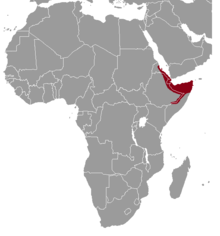Speke comb finger
| Speke comb finger | ||||||||||||
|---|---|---|---|---|---|---|---|---|---|---|---|---|

Speke comb finger ( Pectinator spekei ) |
||||||||||||
| Systematics | ||||||||||||
|
||||||||||||
| Scientific name of the genus | ||||||||||||
| Pectinator | ||||||||||||
| Blyth , 1856 | ||||||||||||
| Scientific name of the species | ||||||||||||
| Pectinator spekei | ||||||||||||
| Blyth , 1856 |
The Speke comb finger ( Pectinator spekei ), also known as the Bushtail Gundi , is a rodent in the family of the comb fingers (Ctenodactylidae) and the only species in the genus Pectinator .
features
The species reaches a head-body length of 15.5 to 19 cm and a tail length of 6 to 8 cm. The tail thus reaches 224% of the rear foot length and is therefore relatively long compared to other comb fingers. The average weight of four copies was 178 g. The Speke comb finger has ash gray fur with brown or black shading on the top. The sides are solid gray and the underside light gray. Black hair on the outside of the bushy tail forms a dark wreath. The long vibrissae are also black. Like the other comb fingers, the species has a brush comb made of stiff hair on its hind feet. The ears, which are not as flattened as those of the other family members, are characteristic. They are almost naked except for short white hair around the edges. There are four fingers or toes on the hands and feet.
distribution and habitat
The Speke comb finger occurs in the Horn of Africa in Eritrea , Ethiopia , Somalia and Djibouti . He can be found in the lowlands and in mountains up to 1200 meters above sea level. Rocky areas and semi-deserts serve as habitats . Bush or grasslands are rarely visited. In the Danakil desert , population densities of up to 237 individuals per hectare were found in the early 1980s .
Way of life
This rodent rests in crevices or under stones. It becomes active shortly after sunrise and can mostly be seen while sunbathing. In the hot hours of the day, the Speke-Kammfinger takes a break. The species only eats parts of plants such as grass, herbs or leaves. The latter come from the Senegal acacia , among others . In the dry season, the food supply can sometimes become relatively scarce. Several families form a colony that lives in a well-defined area of 1500 to 2000 m². In the event of danger, the animals emit an alarm call that begins with a chirp, followed by a long whistle, followed by three to six chirps. The duration of the call is up to 1.5 s and reaches a frequency of 1 to 4 kHz. The Speke comb finger shares its habitat with the hyrax ( Procavia capensis ).
In the Danakil desert, the young are born from late August to mid-September after the short rainy season, in other areas births were also recorded in January. In captive individuals, a litter usually consisted of one young and rarely of twins. The newborns weigh about 20 g and are completely hairy. They are suckled for 11 to 12 months, after around 174 days they have about the weight of the adult animals.
status
The species is not seen very often. On the other hand, they are widely distributed and no drastic changes by humans are to be expected. The International Union for Conservation of Nature (IUCN) lists the Speke-Kammfinger as not endangered ( Least Concern ).
swell
- Don E. Wilson , DeeAnn M. Reeder (Eds.): Mammal Species of the World . A taxonomic and geographic Reference . 3. Edition. 2 volumes. Johns Hopkins University Press, Baltimore MD 2005, ISBN 0-8018-8221-4 (English, Pectinator ).
- Ronald M. Nowak: Walker's Mammals of the World. Volume 2. 6th edition. Johns Hopkins University Press, Baltimore MD et al. 1999, p. 1622, ISBN 0-8018-5789-9 .
- Kingdon, Jonathan (Ed.): Mammals of Africa . A & C Black, 2013, ISBN 978-1-4081-2254-9 , pp. 638-640 (English, Peke's Pectinator ).
- Pectinator spekei inthe IUCN Red List of Endangered Species 2015.2. Posted by: Coetzee, N. & Grubb, P., 2008. Retrieved July 12, 2015.
